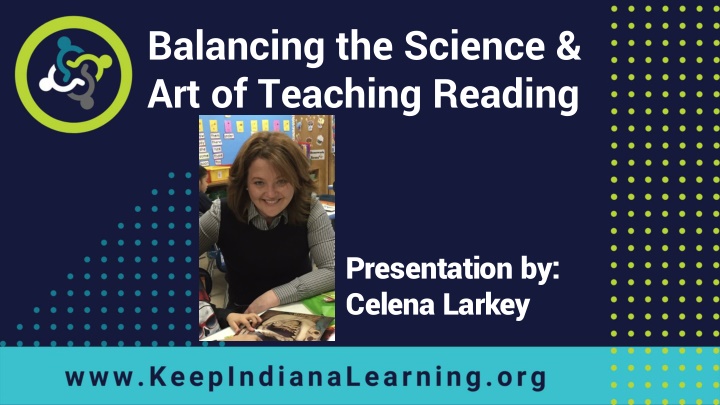
Teaching Reading: Balancing Science and Art by Celena Larkey
Explore the science and art of teaching reading through decoding, understanding text, approaches to teaching, and the importance of phonological awareness. Gain insights on the right methods and the significance of letter-sound knowledge in literacy development.
Download Presentation

Please find below an Image/Link to download the presentation.
The content on the website is provided AS IS for your information and personal use only. It may not be sold, licensed, or shared on other websites without obtaining consent from the author. If you encounter any issues during the download, it is possible that the publisher has removed the file from their server.
You are allowed to download the files provided on this website for personal or commercial use, subject to the condition that they are used lawfully. All files are the property of their respective owners.
The content on the website is provided AS IS for your information and personal use only. It may not be sold, licensed, or shared on other websites without obtaining consent from the author.
E N D
Presentation Transcript
Balancing the Science & Art of Teaching Reading Presentation by: Celena Larkey
Balancing the Science and Art Of Teaching Reading Celena Larkey Founder, Crafted Literacy Collective LLC craftedliteracycollective@gmail.com
Now Read This: ler itati st l se Lezen read
What Constitutes Reading? A: Reading is decoding and understanding written text. Decoding requires translating the symbols of writing systems (including braille) into the spoken words they represent. Understanding is determined by the purposes for reading, the context, the nature of the text, and the readers strategies and knowledge. B: Reading is decoding and understanding text for particular reader purposes. Readers decode written text by translating text to speech, and translating directly to meaning. To understand written text, readers engage in constructive processes to make text meaningful, which is the end goal or product. C: Reading is the process of deriving meaning from text. For the majority of readers, this process involves decoding written text. Some individuals require adaptations such as braille or auditorization to support the decoding process. Understanding text is determined by the purposes for reading, the context, the nature of the text, and the readers strategies and knowledge. Cline, F., Johnstone, C., & King, T. (2006). Focus group reactions to three definitions of reading (as originally developed in support of NARAP goal 1). Minneapolis, MN: National Accessible Reading Assessment Projects. Available on the World Wide Web at www.narap.info.
Four Approaches of Teaching Reading... Phonics Whole-word approach Language Experience Context Support
There is One Right Way? Is there One Right Way? There is a system to how written English (and other) language is both decoded and encoded. The science behind the learning of this system is largely unchanged since the inception of written language. The art humans bring to this learning has shifted and changed over time.
The Science of Reading Letters and sounds: Letter-sound knowledge is essential for both phonic decoding and sight-word learning. Phonic decoding: Early phonological awareness skills enable the development of letter-sound knowledge and should be targeted for direct instruction through first grade. Advanced phonological awareness skills should continue to be assessed and practiced through third grade to ensure that a solid orthographic lexicon is established. Orthographic mapping: Understanding orthographic mapping allows for teachers to support students who struggle to read. Orthographic mapping is the process that occurs when unfamiliar words become automatic sight words. The research on orthographic mapping explains how students develop this vast sight word bank for accurate and automatic word retrieval and also why students with reading problems struggle to develop this skill.
The Art of Teaching Reading Whole Language Practices Components of Literacy Instruction Conditions of Learning
Finding Balance, Choosing Balance Methods work best when employed by informed teacher decision makers Children are at the center of our instructional practices -Systems and methods deserve to be studied so they can be arranged and taught by informed professionals that means us. Teaching children to read and growing readers are not opposite aims
Thank you! Place presenter headshot over this text. Add presenter contact information in the text box below. Visit KeepIndianaLearning.org for more professional learning opportunities. Celena Larkey Crafted Literacy Collective LLC
Thank you for attending! Please complete the short feedback survey on the screen. Don t forget to download your PGP Certificate from the webcast toolbar.
